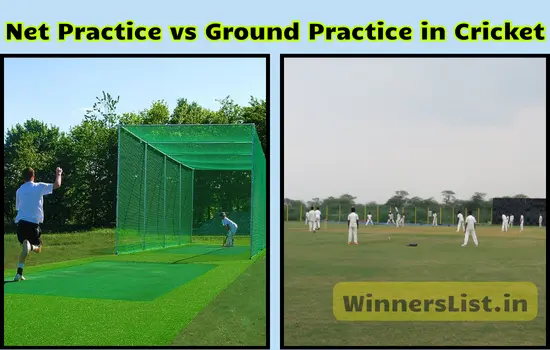Cricket players often debate whether net practice or ground practice is more beneficial. Both have unique advantages and disadvantages. Here, we will explore the differences, pros, and cons of each to help players decide which suits their needs best.

Net Practice
What is Net Practice?
Net practice involves practicing cricket skills, especially batting and bowling, within an enclosed area called a net. The net surrounds the practice area to prevent the ball from traveling far, making it easier to retrieve.
Pros of Net Practice
- Focused Practice: Players can focus on specific skills, such as batting against spin or improving a particular bowling delivery.
- Repetition: Batsmen can face a high number of deliveries in a short period, leading to more practice.
- Safety: The enclosed space minimizes the risk of losing balls and reduces the chances of injury from stray balls.
- Convenience: Nets can be set up almost anywhere, including backyards, which makes them accessible.
Cons of Net Practice
- Limited Space: The enclosed area restricts the full range of shots and running between the wickets.
- Less Realistic: It doesn’t fully replicate the conditions of a live game, such as field placements and match pressure.
- Predictable: Bowlers might get into a rhythm that is not as challenging for batsmen, making it less effective for real match preparation.
Also See: Cost of Cricket Net Practice in Delhi’s Local Grounds
Ground Practice
What is Ground Practice?
Ground practice involves practicing on an open cricket field, simulating actual match conditions. This includes batting, bowling, fielding, and running between the wickets.
Pros of Ground Practice
- Realistic Conditions: Players experience match-like conditions, including pitch variations and field placements.
- Holistic Training: It allows for comprehensive practice, including running between the wickets and working on fielding positions.
- Team Coordination: Helps improve team strategies and communication, crucial for match situations.
Cons of Ground Practice
- Time-Consuming: Setting up and conducting ground practice sessions takes more time compared to net practice.
- Resource-Intensive: Requires more space, equipment, and often more players, which might not always be available.
- Weather Dependency: Outdoor practice can be hindered by weather conditions like rain or extreme heat.
Which is Better?
The answer depends on what the player needs at a given time.
- For Skill Development: Net practice is excellent for honing specific skills through repetitive practice.
- For Match Preparation: Ground practice is better for experiencing real match conditions and improving overall gameplay.
Conclusion
Both net practice and ground practice play vital roles in a cricket player’s development. Utilizing a combination of both can provide a balanced approach, helping players improve specific skills while also preparing them for the real challenges of match play.

Hello, I’m Kapil Kumar, a seasoned SEO expert and blogger at WinnersList.in. My mission is to spotlight exceptional individuals and organizations across various domains. Through curated lists, profiles, and inspiring stories, I aim to celebrate outstanding achievements and inspire the next generation of champions. Join me in this journey.
